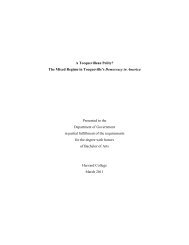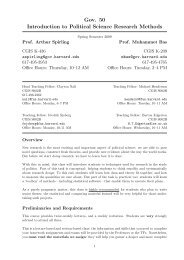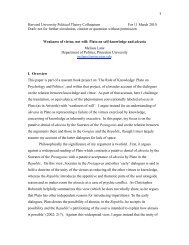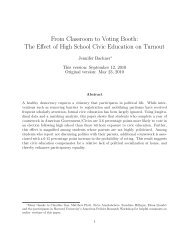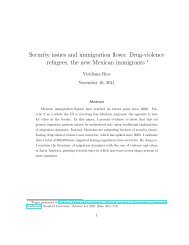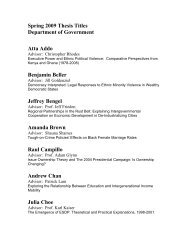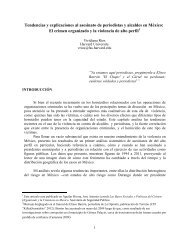Supreme Court Agenda Setting in a System of Shared Powers Ryan ...
Supreme Court Agenda Setting in a System of Shared Powers Ryan ...
Supreme Court Agenda Setting in a System of Shared Powers Ryan ...
Create successful ePaper yourself
Turn your PDF publications into a flip-book with our unique Google optimized e-Paper software.
20 The Journal <strong>of</strong> Law, Economics, & Organization. V0 N0<br />
Spriggs, 2004), the results here strongly suggest that the <strong>Court</strong> does not heed<br />
the preferences <strong>of</strong> Congress and the president.<br />
How might scholars and policymakers respond to a <strong>Court</strong> potentially out <strong>of</strong><br />
l<strong>in</strong>e with majoritarian preferences? One response is to do noth<strong>in</strong>g. An <strong>in</strong>dependent<br />
<strong>Court</strong>, after all, may provide a safeguard aga<strong>in</strong>st the tyranny <strong>of</strong> popular<br />
passions. As Alexander Hamilton stated, judicial <strong>in</strong>dependence guards<br />
the Constitution and the “m<strong>in</strong>or part <strong>of</strong> the community” from “those ill humors<br />
which the arts <strong>of</strong> design<strong>in</strong>g men” legislate (Hamilton, 1788). Besides,<br />
the <strong>Court</strong> median fell outside the legislative equilibrium no more than 13 terms<br />
between 1953 and 1993, depend<strong>in</strong>g on the legislative model studied. Rotation<br />
<strong>in</strong> <strong>of</strong>fice, it would seem, largely keeps the <strong>Court</strong> majoritarian (Dahl, 1957).<br />
Attack<strong>in</strong>g the <strong>Court</strong> for its counter-majoritarian decisions may stir up more<br />
trouble than it is worth.<br />
An alternative response, however, would challenge the <strong>Court</strong> either through<br />
term limits or other <strong>Court</strong> curb<strong>in</strong>g bills (Calabresi and L<strong>in</strong>dgren, 2006b,a).<br />
Such a regressive response might force the <strong>Court</strong> to adopt positions more <strong>in</strong><br />
l<strong>in</strong>e with current majorities. Indeed, if the <strong>Court</strong> stays majoritarian because<br />
<strong>of</strong> frequent rotation <strong>in</strong> <strong>of</strong>fice, policymakers may wish to ensure rout<strong>in</strong>e rotation.<br />
In its absence, the <strong>Court</strong> could drift from contemporary majorities and<br />
f<strong>in</strong>d itself compet<strong>in</strong>g with dom<strong>in</strong>ant political regimes (Calabresi and L<strong>in</strong>dgren,<br />
2006b). If justices fail to respond to SOP <strong>in</strong>fluences <strong>in</strong> a systematic manner<br />
over a long enough time period, the <strong>Court</strong> might become the target <strong>of</strong> political<br />
retribution (Eskridge, 1991). Indeed, some legal scholars even argue that: “[i]n<br />
the long run, majorities <strong>in</strong> America will always have their way” (Rosen, 2006,<br />
xiv).<br />
In the end, then, these results speak both to the empirical debate about<br />
whether the <strong>Court</strong> is counter-majoritarian, as well as the normative debate<br />
about how to treat such an <strong>in</strong>stitution. Empirically, the data pa<strong>in</strong>t a clear picture<br />
<strong>of</strong> a <strong>Court</strong> which fails to consider legislative and executive preferences<br />
when sett<strong>in</strong>g its agenda. Normatively, these f<strong>in</strong>d<strong>in</strong>gs may be a virtue or a vice,<br />
depend<strong>in</strong>g on one’s predispositions. Nevertheless, these results are surely important<br />
to those with a stake <strong>in</strong> the outcome.



